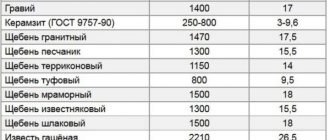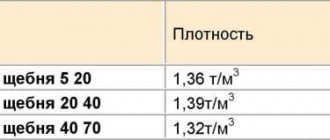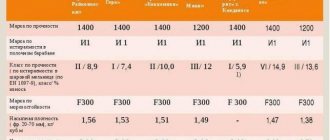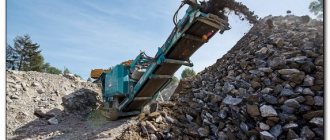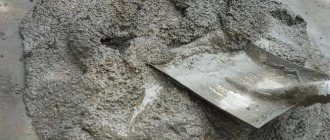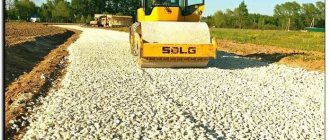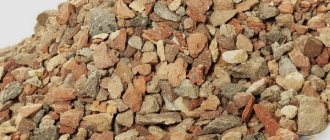Crushed stone is a bulk inorganic building material obtained by crushing natural stone or solid waste building materials. Crushed stone is usually called primary. Pebbles, boulders, pumice, granite and other natural stones are used for its production. Crushed stone obtained from construction waste is called secondary. To obtain it, pieces of concrete, asphalt or brick are processed by crushing.
Crushed primary crushed stone is obtained by screening rocks extracted from quarries. Secondary crushed stone is produced using mechanical crushers, into the receiving hopper of which pieces of concrete, asphalt or crushed brick are loaded.
Both types of crushed stone have very useful properties for construction. They are excellently fixed on surfaces covered with cement mortar. This property is actively used in construction, including roads and railways.
Density
The most important parameter for determining the quality of crushed stone is density. It is the density that determines the strength of the future road surface or building structure. The density of crushed stone is determined by the ratio of mass to volume. It is customary to measure it in tons or kilograms per cubic meter. To more accurately assess density, it is measured in two ways. The first is the total (bulk) density, which takes into account the air space between pieces of dry crushed stone. The second option is true density, which is measured without taking into account the empty space in the measuring container. To do this, crushed stone is additionally crushed in the laboratory until the porosity of the mass is completely eliminated. Such an analysis is done to obtain the most accurate result for carrying out critical engineering calculations. In practice, the bulk density parameter is used much more often. It is this unit of measurement that is used in the production of crushed stone-cement mixtures.
The density of crushed stone can be measured in different ways. Most often this is done using measuring containers or tables. A cylindrical vessel with a capacity of five to fifty liters is used as a measuring container. It is filled with crushed stone with a slide. Then the slide is removed so that not a single crumb rises above the edge of the vessel. After this, the vessel with crushed stone is weighed and the weight of the empty vessel is subtracted from the result obtained. The net weight of the crushed stone is divided by the volume of the vessel and a real indicator of the density of a given batch of crushed stone is obtained.
This measurement can be expressed by the formula: Рн = (m2 - m1): V, where m1 is the mass of the empty vessel; m2 is its mass with crushed stone, V is its internal volume.
Measurement of crushed stone density is done in accordance with GOST requirements. It is allowed to use vessels of strictly defined shapes and sizes. To measure the density of crushed stone of different fractions, only appropriate measuring containers are used. When pouring crushed stone into a vessel, it is prohibited to compact the material, otherwise the measurement will not correspond to the actual density of a given batch of crushed stone. The total density of crushed stone is always higher than the bulk density, and this is quite understandable. Both measurement results are indicated in the accompanying documents. The density of any bulk building materials is measured in a similar way.
It is also possible to measure the density of crushed stone using special tables. In this case, the measurement error will be about one percent. That is, such an error is not critical when designing road surfaces or building structures. The tables show the results of measurements of the density of various types of crushed stone, previously obtained in the laboratory. Using the conversion factor and table data, it is easy to determine the density of a specific batch of crushed stone.
For builders, an important indicator is the bulk density of crushed stone. The strength of the structure or roadway will depend on its size. In addition, the bulk density indicator allows you to take into account the density of the substance that will fill the voids between the pieces of crushed stone. The density of the substance will in any case be lower than the density of crushed stone, even if it is dry sand. In this way, engineers can calculate the actual strength of building or road elements. In addition, knowing the real value of the bulk density of crushed stone allows you to obtain certain savings. For example, with a high bulk density of crushed stone, the rate of cement consumption for the production of the mixture can be significantly reduced. This indicator is also important for the optimal organization of transportation of crushed stone and the selection of the most economical vehicle for this.
Methods for calculating the coefficient
The bulk density indicator is calculated on the basis of GOST before performing construction work. The calculation process involves the following steps:
- a cylindrical container is prepared in accordance with the fractions of crushed stone (for raw materials with granules up to 10 mm, take a 5-liter tank, up to 20 mm - 10 l, up to 40 mm - 20 l, over 40 mm - 50 l);
- the crushed stone being examined is dried and cooled to obtain the most accurate data;
- a cylindrical tank filled with crushed stone mixture is weighed, after which the net weight of the non-metallic material is calculated;
- the resulting number is divided by the volume of capacity used.
Bulk density
To convert the mass of crushed stone into volume and vice versa, a unit of measurement is used, such as the bulk density coefficient. This unit is sometimes called the conversion factor or compaction factor. It is worth talking about this coefficient in more detail, giving examples. When crushed stone is brought to a construction site, it is always compacted along the way due to shaking. That is, at the factory the dump truck body was loaded to its full capacity, but the truck arrives at the construction site with an underloaded body. If there was no theft, then the mass of rubble from shaking did not change. The conversion factor allows you to determine this. There is one for each type of crushed stone. The recipient of the cargo knows the volume of the dump truck body and can easily measure the volume of crushed stone in it. By multiplying it by the conversion factor, the recipient will determine the actual weight of the delivered material. This is how crushed stone consumption is recorded.
The conversion coefficient is not constant; it is different for each type of bulk materials. Its absolute value depends on the density of the material, in our case it is crushed stone. So the weight of one cubic meter of granite chips is 2.6 tons, and the same volume of limestone chips will weigh from 2.7 to 2.9 tons. Limestone is heavier than granite due to the presence of dolomite and quartz in its structure. It is clear that with equal weight of two types of crushed stone, their volume will be significantly different.
The difference in volumes with the same mass will be indicated by the true and bulk density of crushed stone. For example, the true density of granite crushed stone with a fractionation of 5-20 millimeters is 2590 kg/m3, and the bulk density for the same volume of granite crushed stone is only 1320 kg/m3. Knowledge of these quantities allows you to accurately calculate the required amount of crushed stone, sand and cement for the manufacture of a specific building product or structural element.
Helpful information
Crushed stone
is a building material obtained by crushing rocks, heavy industrial waste or recycling. It differs in fractions (sizes of the resulting fragments) and rocks from which it was obtained.
According to the last parameter, crushed stone is distinguished:
- granite;
- gravel;
- limestone;
- slag;
- secondary.
Granite and limestone crushed stone are products of crushing the corresponding rocks, gravel is the result of crushing river gravel, slag is obtained by crushing iron production waste, and secondary is obtained by processing, crushing and sorting by size of old concrete or brick structures.
Areas of application of the main fractions of crushed stone
Crushed stone from natural stone is used for various types of construction work:
- Fraction 0-5
is actually screening, which is used primarily for decorative purposes - backfilling paths, platforms, flowerbed areas, etc. In construction, it can be used for drainage of dirt routes or in some concrete products that do not require special strength. - Crushed stone of fraction 5-20
is the most commonly used option for the production of concrete for the construction of building structures and structures. Crushed gravel with a fraction of 5 to 20 is also used for roads with low traffic, as part of some building mixtures and for cladding buildings. - Crushed gravel 20-40
is used for filling roads, both automobile and railway (including tram tracks), and is used as drainage. In industrial premises with heavy loads, this fraction is used for laying in foundations to strengthen them and increase their bearing capacity. This and the previous fractions are used to fill pillows under the foundation. - Crushed gravel with a grain size of 40-70
is also used in the production of concrete, but for large-scale structures such as large bridges, etc. When laying airfield pavements, the first layer is poured with such crushed stone.
Crushed gravel for construction work, obtained by crushing sea and river stones, is characterized by good adhesion to the concrete mixture, while being low in price and available in all regions of the country, i.e. in most cases it can serve as an excellent replacement for more expensive granite crushed stone.
Main characteristics of crushed stone
- The flakiness
of a material characterizes the shape of its grains.
It expresses the percentage of grains in the total mass that are needle-shaped and flat, plate-like in shape. Such grains have the worst adhesion to concrete and cement mixtures, therefore, with a large number of them, the strength of the structure is greatly reduced. The close-to-cuboid shape makes it possible to significantly save fine aggregate
due to the fact that the crushed stone grains are more closely adjacent to each other. - The strength
of crushed stone is characterized by the compressive strength of the original rock from which it was obtained, as well as by the crushability of the grains themselves when compressed in a cylinder. - The radioactivity
of crushed stone affects the possibility of its use in various fields.
So, in order for crushed stone to be used in residential construction, it must comply with radioactivity class 1 (less than 370 Bq/kg)
; for industrial facilities and road construction,
radioactivity class 2 (up to 740 Bq/kg)
.
The use of class 3
is permissible when constructing roads (provided that there is a layer of soil or other material at least half a meter thick on top of the crushed stone) and the construction of industrial facilities outside populated areas. These standards for the use of crushed gravel apply both in Moscow and throughout Russia, which is strictly controlled by the relevant authorities. - Frost resistance
of crushed stone indicates the number of cycles of freezing and subsequent thawing that the material can withstand without destruction, significant loss of strength and other important characteristics.
According to this parameter, crushed stone is classified into grades from F15 to F 400
. - The density
of building crushed stone is divided into two types - true and bulk.
The first refers to the density of the stone material itself from which this crushed stone is obtained. Bulk density, as its name implies, refers to the material in its poured state, i.e. takes into account the air gaps between grains. The bulk density of crushed stone 5-20 is approximately 1350-1360 kg/m3
; - The bulk density of crushed stone is 20-40 according to GOST due to the larger number of air gaps, slightly less - 1320-1330 kg/m3
; - The bulk density of gravel crushed stone of fraction 40 70 fluctuates in the range of 1300-1320 kg/m3
.
Requirements for the main characteristics of natural crushed stone used for construction work are regulated by a regulatory document - GOST for construction crushed stone.
How to determine the required amount of crushed stone
Knowing the density of crushed stone, you can easily calculate how much of it will be required for a particular building structure of a certain size:
- For example, to understand how many cubes of material are in a ton of crushed stone 5-20, you need to divide one (that is, one ton) by the density of crushed stone of this fraction.
- If you need to find out the inverse ratio, that is, how many tons, for example, there are 20-40 in a cube of crushed stone, then no calculations are required, you just need to clarify the density of this material.
Fraction and strength
Parameters such as fraction and strength are also considered important for indicating the quality of crushed stone. The fraction, in other words, the size of crushed stone can be standard, non-standard and European. Crushed stone of the standard fraction has sizes of 5-10, 10-20, 5-20 millimeters, and not the standard fraction of 10-15 and over 15-20 millimeters. European crushed stone has dimensions from 3 to 5 millimeters. The strength of crushed stone can be normal - M 800-1200; high - M 1400-1600; medium - M 600-800; weak - M 300-600 and minimal - M 200.
One of the main characteristics of crushed stone is density. And it is not surprising, because the strength of the building material, and therefore the structures for which it is used, depends on it. When calculating, it should be taken into account that if the stones are in bulk, then their weight in a conventional cube will differ by approximately two times.
What affects the volume of crushed stone?
The only characteristic that affects the volume of crushed stone is its fraction. If there is only one faction, then it will not settle tightly even with strong shaking. Due to this, a large number of voids are obtained, and the larger the fraction, the less the cubic meter will weigh. The densest is the so-called granite screening, which is more reminiscent of fine gravel. It weighs so much that you need to be careful when filling trucks so as not to tear the frame and springs.
The volume also greatly depends on the nature of the rock and on the equipment installed at the mining and processing plant. The fact is that only cuboid and prismatic fragments demonstrate the best compaction.
The flakiness of crushed stone greatly reduces its density, which will also then affect its density. Crushed stone can also be limestone. Not only is the density of this rock quite low, but also the curved fragments that form the fraction fit very poorly with each other. That is why this material is only suitable for road construction. It should only be used as a concrete filler as a last resort. You can use it to build a one-story building - a house, garage or barn. The second floor on concrete made of crushed limestone will be unpredictable.
Water absorption is an equally important factor in determining the weight of a cubic meter of crushed stone. Neglecting this factor in calculations will result in inaccurate results. Water absorption is also influenced by different rock porosities and different fraction sizes, and if they are not taken into account, the calculations will be incorrect.
How many liters of water are in a cube?
Putty consumption per 1m2 - consumption of starting and finishing putty
This is interesting: What is crushed stone screening: types and applications
Specific Gravity
When calculating the proportions for preparing a concrete mixture, it is necessary to know the bulk density of crushed stone, since the ratios of the components are taken in volumetric terms per m3. This indicator will vary even for one rock lithotype, which is dispersed into different fractions. Thus, the finer the gravel grains, the more densely they are packed, which means that the bulk density also increases (it is also called apparent or specific). In addition, you should also take into account the fact that there are more air gaps between large stones, therefore, 1 m3 of building material will weigh less. This is not the best option for preparing concrete, because all these “pockets” or voids will have to be filled with sand or a more expensive material – cement. Meanwhile, for the installation of a cushion under concrete or road surface, the use of large fractions of crushed stone justifies itself. Knowing the specific density of a building material also helps, if necessary, organize its transportation or storage. Moreover, it is not difficult to find out this value if you have a container whose volume is predetermined. You will also need scales with sufficient lifting capacity. Just pour crushed stone into a container and weigh it. The results minus the container, divided by its volume - this is the desired value, expressed in t/m3 or kg/m3.
True Density
True density is the average density of crushed stone grains. This indicator should be as high as possible, because it is inextricably linked with the other strength characteristics of the aggregate. However, this indicator cannot be influenced, since the true density depends on the type of rock. You won’t be able to calculate it yourself - this can only be done in laboratory conditions. Therefore, the consumer can only rely on his own correct choice and purchase crushed stone of suitable origin.
Conclusion
Density directly depends on the type of material from which crushed stone is made; this is one of the key parameters. The fraction also has an effect, because large particles rub together less well and an air gap is created. Accordingly, the less material is placed, the less the weight will be.
Using calculations taking into account the listed factors, you can save money on laying the foundation, forming a cushion, and also preliminarily estimate the cost of the project. Take these points into account and the construction will be at the highest level.
Comparison of indicators
As we know, crushed stone is produced from several types of rocks. Some of them are more affordable, and finding them on the market is not difficult.
When using crushed stone in construction work, it should be remembered that the bulk density of fractional aggregate varies slightly depending on the degree of compaction. So, for example, well-compacted crushed stone of a fraction of 40-70 mm can have the same weight in t/m3 as loose crushed stone of a fraction of 20-40. This feature of this building material raises many questions when accepting it after delivery to the construction site. According to GOST, the compaction coefficient is equal to 1.1. However, when drawing up a contract, options for revising it downwards are possible. In this case, the crushed stone while still in the back of the truck should be measured and multiplied by a coefficient previously agreed upon with the supplier. If the result corresponds to the paid volume or slightly exceeds it, then, of course, there are no complaints against the seller.
Compaction coefficient (Ku)
This is an indicator of the ability of crushed stone to compact under certain influences.
Ku is determined by the ratio of the density of crushed stone to the density artificially created by special laboratory devices.
The methodology for its calculation is described in GOST 8269.0–97. The standard gives a division into three types:
- true density of grains and rock;
- average density of crushed stone and rock;
- bulk density to crushed stone voids.
Crushed stone is classified into types. All types have their own marking established by GOST 8267-93. This standard specifies methods for setting the coefficient. During manufacture, the manufacturer indicates Ku in the passport, but there are cases when such information is missing. Experts in laboratories experimentally determine this indicator within three days. It is also possible to determine it at a construction site, but the price for the work will be significantly higher.
The average Ku value ranges from 1.1 to 1.3.
Why is Ku needed?
Firstly, for purchasing. Thanks to this indicator, the required quantity can be easily calculated. Secondly, in order to understand how much the bulk material will settle after compaction.
How to calculate the required amount of crushed stone
Volume of the mold to be filled (m 3 ) × specific gravity (kg/m 3 ) × compaction coefficient.
There are tables of average mass, example:
1 m3 of fraction 0–5 mm is equal to 1.5 t;
1 m3 of fraction 40–70 mm is equal to 1.47 tons.
In practice this is a simple procedure:
- the size of the sides of the truck is measured;
- find out the total volume of crushed stone;
- We multiply the resulting figure by the standard compaction coefficient for the imported fraction.
As a result, we easily checked the actual amount of crushed stone brought.
Main characteristics
As a rule, crushed stone is made from rocks that have a fairly high grain size when chipped. After crushing such rocks, stone chips of various sizes with a rough surface and uneven edges are obtained. This feature ensures reliable adhesion to cement, which guarantees the solidity of the future concrete. The shape of the grains, which is responsible for adhesion, is usually called the flakiness of crushed stone. This indicator is expressed as a percentage. A low flakiness index indicates that the rock contains a large number of “tenacious” grains-plates and needles. However, high flakiness, which means that cuboid-shaped grains predominate in the mixture, is also in demand. This material lends itself well to compaction and compaction, which means it can be successfully used when backfilling foundation cushions and working with bituminous compounds.
In addition to density and strength, crushed stone has other important characteristics that reflect its ability to absorb moisture and frost resistance.
The most common types of breeds
Here are the most common types of rocks from which crushed stone is usually made. In first place in terms of frequency of use and popularity is granite. Crushed stone obtained from this rock is very strong, up to grade M1400. This makes it possible to use it for the production of heavy concrete, the strength of which is subject to high demands. Granite has a very low degree of moisture absorption, which in mass terms does not exceed 0.2%. Thus, the frost resistance of granite crushed stone is quite high - about 400 cycles. Granite crushed stone is rightfully considered the best, and therefore the most expensive.
The second most popular type of rock for crushed stone production is limestone. It is clear that in terms of its characteristics it is much weaker than granite, however, its density is 2.7-2.9 t/m3. Such a high density indicator ensures the content of dolomite, quartz, and other particularly strong minerals in limestone rocks. However, the overall strength does not rise above M800 due to weaker bonds between the components. Frost resistance is no more than 150 cycles, due to the fact that limestone absorbs about 2.5% moisture. These features should be taken into account when calculating the amount of water for the solution. Moreover, such characteristics make the use of this rock for construction in the northern regions impossible. In all other areas, mainly only crushed limestone 20-40 mm is used.
Properties
The use of limestone has been known since the construction of the Egyptian pyramids. The huge building blocks from which these historical and architectural monuments are made are of calcareous nature. The age of these structures is, according to some estimates, approximately 5,000 years.
The sphinx figure located nearby has even more ancient origins.
Sphinx figure
This characterizes the quality of this building material. Initially, the surfaces of the outer building blocks of the pyramids were polished to a mirror finish, which made the structures look like precious crystals from afar.
The main chemical component of the material is CaCO3, often in the presence of manganese, silicon, and iron compounds.
There are many varieties of limestone, such as shell rock, tuff, chalk, pisolite limestone, marl (a mixture of clay and calcite), and crystalline rock.
Shell rock
Coral reefs are also a variety of this material. All of the listed materials differ significantly in their physical characteristics and areas of use. The color of the minerals also differs, but white predominates.
What is the difference between granite and limestone crushed stone?
Granite crushed stone is a product of crushing granite rocks (formation of stones of various shapes and sizes). The main advantages of granite include: increased hardness and low water absorption. The last of these properties is significant, especially in the construction of pools and fountains. Granite does not deform under the influence of moisture.
Limestone has been used in construction since the construction of the Egyptian pyramids. The huge blocks used in their construction are carved from limestone. It is impact-resistant, despite the fact that it is significantly inferior in strength to granite.
The main advantage of limestone is its environmental cleanliness . What is it expressed in? First of all, it has a very low level of radioactivity, unlike other rocks, including granite. In addition, crushed limestone is extremely resistant to temperature changes.
These properties determine its primary use in road construction, as well as for the production of concrete. It also finds application in the construction of drainage systems. Another undoubted advantage is the relatively low price compared to the prices of crushed granite or gravel.
Limestone is used not only as a building material. The glass, food and printing industries use it widely. Many useful products are obtained from it, including:
- soda, calcium carbide;
- various mineral fertilizers;
- quicklime.
Physical and technological properties of crushed limestone
Let us give a definition and give numerical values of the main physical and technological properties of limestone crushed stone. Fraction. A fraction is a part of a bulk or lumpy solid, as well as a liquid mixture, separated on the basis of a certain characteristic. For crushed stones, such a sign is the limiting values of the linear dimensions of individual pieces of rock (grains) of this fraction. That is, the minimum and maximum overall length of the grains.
For bulk materials, there are 3 types of fractions: main, accompanying and non-standard. The main fraction includes particles whose sizes are in the range: 5-10 mm, 10-20 mm, 20-40 mm, 40-70 mm and some others. The accompanying fraction is called the fraction, which includes pieces whose dimensions are less than 5 mm. Non-standard particles include groups of particles with sizes 80-120 mm, 120-150 mm.
Flakiness. This property characterizes the grain composition of crushed stone. It is one of the important properties of crushed stone. This term got its name from the word “bream” (that’s what they used to call a flat wooden plank or stone tile). This characteristic is measured as a percentage. It can be calculated as the ratio of the total mass of grains having a non-standard (plate-like and needle-shaped) shape to the mass of a given amount of crushed stone.
The flakiness of crushed stone affects the course of various processes (production and construction). You should also know some auxiliary definitions. Lamellar grain is a grain whose length is 3 or more times less than its thickness. The needle grain has a width 3 or more times smaller than its length. Crushed stone of various types according to GOST, depending on the flakiness indicator, is divided into 5 groups.
The first group (contains up to 10% needle-like and lamellar-type grains) is called cuboid due to the relatively low proportion of non-standard grains. The fifth group contains from 35% to 50% of the above types of grains. Note that the compaction density of crushed stone directly depends on the flakiness. After all, the more non-standard grains in a fraction, the higher the likelihood of voids forming between them. Therefore, it is quite obvious that a structure made of cube-shaped crushed stone should be more durable.
The flakiness of crushed limestone by main fractions is: a) 10-12% (5-20 mm); b) 11-12% (20-40 mm); c) up to 15% (40-70 mm). From these values it is clear that crushed limestone belongs to the 2nd, so-called improved group.
Frost resistance. This property is characterized by the number of complete cycles that do not lead to loss of original properties through freezing and thawing of the sample. In addition, it can be assessed by the number of samples associated with the saturation of stones with sodium sulfate followed by drying.
Crushed stone, according to this parameter, is divided into several grades (F15, F25, F50, F100, F150, F200, F300, F400). The frost resistance value of crushed limestone varies from 100 to 150. According to modern requirements, in construction it is recommended to use mainly crushed stones with a grade of at least F300.
Flakiness
The flakiness characteristic is quite important, since the amount of a specific grain shape reduces the density of crushed stone. Thus, in addition to grains with a diameter of 20 mm or 40 mm, the crushed stone contains needle-like or powdery pieces of rock, which increase the amount of voids in the material.
This parameter is very individual, since even from the same quarry crushed stone with a different percentage of flakiness can be produced. Accordingly, a decrease in this indicator leads to an increase in the compaction coefficient.
A high-quality manufacturer tries to minimize the amount of these residual grains in crushed stone, but such a product is somewhat more expensive.

